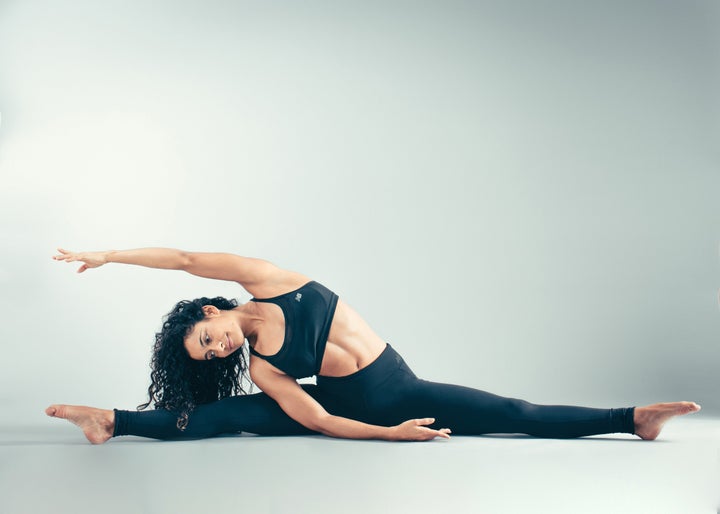Do your friends ever comment on your weirdly bendy thumbs or the fact that you can touch the floor with your palms without bending your legs? As well as being a fun party trick, this may also a be a condition known as hypermobility.
While for many it may be an advantage to be able to bend six ways from Sunday, but it may also carry its share of risks. So what’s the deal?
Hypermobility, also known as double-jointedness, is when an individual has an increased range of flexibility in some or all of their joints.
The condition is understood to be hereditary and thought to be caused by an increased amount of collagen in the joints.
Those affected will have an abnormal range of movement in certain areas of their body, whether that’s being able to bend their thumb back to meet their arm to your arm or touch the floor without bending your knees.
It might sound scary to have joints that bend beyond the normal range, but the majority of cases are asymptomatic (without symptoms) and experts even say it can carry advantages. There are symptomatic cases, where the increased flexibility can cause pain, fatigue or even dislocation, this is known as hypermobility syndrome. And it is important to differentiate between the two.
Hypermobility is extremely common, thought to affect between 10-20% of the population, according to a research paper published in Best Practice & Research Clinical Rheumatology. It’s about three times more common among women and is more prevalent in ethnic minority groups.

The Beighton Scale is a good place to work out whether or not you may be hypermobile. It’s a simple test to assess the mobility of certain joints to see whether they have an above average range of movement.
“Hypermobility is on a spectrum,” explained Dr Jane Simmonds physiotherapy lead - Hypermobility Unit, Hospital of St John and St Elizabeth and senior teaching fellow Great Ormond Street Institute of Child Health, University College London, told HuffPost UK.
“It can affect just one or two joints or be more generalised and affect multiple joints. It can but at the other end of the scale it might be an indication of a connective tissue disorder, such as Ehlers-Danos Syndrome, where collagen is much more fragile. EDS will also carry other symptoms such as fragile skin and increased risk of hernias.”
For adults, a score of four or more on the Beighton scale would indicate generalised hypermobility.
The score is worked out as follows:
- one point if you can place your palms on the ground while standing with your legs straight
- one point for each elbow that bends backwards
- one point for each knee that bends backwards
- one point for each thumb that touches the forearm when bent backwards
- one point for each little finger that bends backwards beyond 90 degrees
Hypermobility may sound scary or risky but experts say it can be an advantage, with people flocking to certain sports such as gymnastics, dance or yoga, due to a natural ability.
Dr Simmonds told HuffPost UK: “If you look at Michael Phelps. He appears to have hypermobile joints and it’s definitely an advantage because he has more flexibility. Many professional gymnasts and ballet dancers will also benefit from a greater range of movement.”
For some, natural hypermobility may lead them to find the perfect career for their body.
Shona Vertue, personal trainer and yoga instructor, told HuffPost UK: “Being raised a gymnast and a dancer meant that what most would deem hypermobility was for me, actually completely normal (and in fact encouraged). Gymnastics couples flexibility with strength and agility, but it was actually dance (in particular ballet) that encouraged the hyperextending joints.”
Although there is limited research in the area, some believe there may be risk of injury for those who are hypermobile. So many experts advise strength training and overall fitness.
“There is nothing wrong with flexibility, so long as it’s supported with an equal amount of stability,” said Vertue.
Luke Worthington, head of education at Third Space, agreed: “You must have strength and control over the range of movement available to you. I’ve worked with athletes from some of the West End’s leading stage shows, as well as with organisations such as Cirque du Soleil. These individuals have extreme ranges of motion available – however – they definitely have strength and control and ‘own’ everything that they can do.”

Worthington explained: “This may be from the fact that you will be getting into positions that you may not have adequate strength or control over.
“A person who is more ‘stiff’ or ‘tight’ may, contrary to popular belief, be less at risk of injury than someone who has excessive mobility. The ‘stiff’ person is more likely to have neuromuscular control over the entirety of range of movement available to them, while a person with hypermobility by definition will be able to go to places beyond the range within which they have control.
“A simple way of describing this is they may be able to get into a position that they can’t get back from. It’s a bit like driving your car without any brakes!”
Vertue said that when she stopped gymnastics, which had a large strength element to it, she felt a difference in her body.
“When I stopped the strength work but maintained flexibility, I did notice an increase in susceptibility to aches and pains. This eventually led to dysfunctional movement patterns which resulted in quite a long battle with sciatic and lower back pain.”
“I made a conscious effort a long time ago that I was going to become as strong, as I was flexible - this meant my strength work had a lot of catching to do. Weight training is a regular part of my exercise regime not just because I enjoy lifting heavy things, but it also helps to keep me pain free - creating extra stability for my increased mobility.”

Dr Caroline Alexander, lead clinical academic for Therapies at Imperial College Healthcare NHS Trust, found on a current research project that people who have asymptomatic hypermobility may be stronger than those with average flexibility.
She said one possible explanation for the increased strength of those with asymptomatic hypermobility have been stabilising their joints their whole life. There is some evidence to suggest asymptomatic hypermobility may develop into symptomatic hypermobility in a minority of cases.
When asked to give specific advice on strengthening, Dr Alexander was cautious.
“As each case of hypermobility differs so widely, it is difficult to give specific tips on how to balance and strengthen your body. I’d recommend increasing overall strength.”
She added: “I would speculate that it is important to strengthen throughout your natural range. You might be weaker in your end range positions [when you are nearing the limit of your hypermobility and maybe have less control] so the exercise has to be appropriate for the strength you have. This may mean less load within the hypermobile range.”
For Vertue strength training certainly seems to have worked. “I made a conscious effort a long time ago that I was going to become as strong, as I was flexible - this meant my strength work had a lot of catching to do. Weight training is a regular part of my exercise regime not just because I enjoy lifting heavy things, but it also helps to keep me pain free - creating extra stability for my increased mobility.”